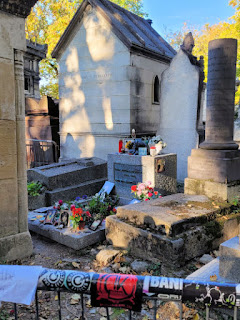Near our hotel was the monument marking the location of the old Bastille. Having become a prison, considered the symbol of monarchical despotism, the old Bastille was stormed by the citizens during the French Revolution in 1789.
It was completely demolished by 1806. This site is now the Place de la Bastille.
There was a metro station right near the hotel ( actually several in easy walking distance) including one at Place de la Bastille. We made good use of the metro system when we weren't walking around Paris.


We really wanted to visit Montmartre and the Sacré Coeur Basilica. Montmarte is a charming village within the city of Paris. You can find lots of artists and bistros and fabulous views of Paris. Sacré Coeur was constructed at the end of the 19th century. Because it is situated atop a hill, you can hike up a lot of steps or buy a ticket for the funicular. Much easier! We really don't have any pictures. There were so many people at this site we could barely move let alone enjoy the area. It turned out that there was an enormous wine festival on this site on the day we tried to visit. Having faced the reality that visiting this site today was a mistake, we escaped back down the hill. Yikes! The Absesses metro station beneath Montmartre is the deepest station underground. There are about 181steps in a spiral staircase. The 181steps down isn't too bad, but the steps up can be a challenge. Apparently there is an elevator somewhere, however. We didn't see it.

Just some of the hot drinks during our Paris visit; L to R: cappuccino, hot chocolate and a café crème. The 4th member of our group had an expresso (décaffeiné). We enjoyed a lot of coffees, etc., just chatting and people watching.

Timed tickets? Really? I know some tourist sites started this prior to the pandemic, but it seems to become practically mandatory everywhere in Paris. When B and I visited Paris 10 years ago, you could rough out what you wanted to do on your visit but you just arrived at whatever museum or location and purchased your ticket on the spot. Not so now. Nearly every venue required pre-purchased timed tickets. There are skip-the-line tickets but you still have to purchase timed entry tickets. Some locations did sell tickets on arrival, but lines were very long and there was no guarantee. Maybe it sounds like a good system in terms of purchasing your tickets, but it doesn't allow for last minute changes and the venues haven't created an adequate system outside of the venue itself to handle the crowds.
We tried to purchase tickets "on the spot" at Sainte Chapelle but they only sell them if there are any tickets left after all the timed ticket owners enter the venue. We waited in line a long time and realized we would be waiting a very long time. Consecrated in 1248, the Sainte Chapelle was commissioned by King Louis IX of France to house his precious collections of Christian relics, including Christ's crown of thorns, acquired by Saint Louis. The stained glass windows are beautiful but with no guarantee of entry, we decided to try to enter La Conciergerie. That went better! We got in.
La Conciergerie is originally part of the royal palace, la Palais de la Cité (construction began in 10th century), which also included Sainte Chapelle. These two are practically next door to each other. In the 14th century, prison cells were added in the lower parts of the building. 2780 prisoners, including Queen Marie Antoinette, were held here before eventually being executed. You can view a cell similar to what the Queen endured. The Concergerie draws less of a crowd so we were able to purchase "on the spot" entrance tickets without too much of a wait. Beneath the secular vaults of La Conciergerie, an artist named Théo Mercier was installing a sand art display. The Exhibition, meant to evoke sleepers guarded by their faithful dogs, wasn't technically open quite yet, but we could watch a little and look at what had been completed. It was fascinating!



My sister-in-law had read about a street artist known as Ememem. This artist fills divots and potholes with multicolor tile mosaics- sort of a French Banksy. It was impossible to find a list of actual locations for this street art so we didn't really think we'd see any. We were wrong! In the area of the Concergerie, etc., we located two artworks.
These two were done together.
Our group of four headed off to see the post-fire situation at Notre Dame Cathedral. There is a tall solid fence surrounding the entire site but you can see what's above the fence. A "hotel" of sorts has been constructed adjacent to the Cathedral as living quarters and office space, etc., for the workers who are re-constructing the cathedral.
The entire remaining exterior of the Cathedral has been cleaned and much work has already been completed. It is anticipated that the Cathedral will be finished and re-opened by 2024 just 5 years after the massive fire that destroyed the roof and toppled the spire. Much of the oak ( maybe not all?) has been harvested within France- very old, very large trees. Notre Dame sits on an island in the Seine River.
On the left is the offices/crew quarters, etc. The building is a huge contrast to the beautiful architecture of the Cathedral.
You can see the solid beige fencing surround the Cathedral in this shot but only when you are right next to it do you realize how tall it is since so much of the Cathedral towers over the fence.
There are drawings to interpret what you are seeing during reconstruction.
A cute alley.
Beautiful artwork on the security screening on the Bank of France.




































































